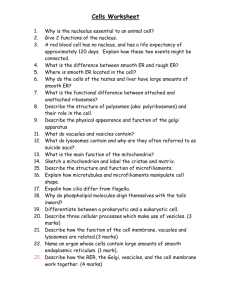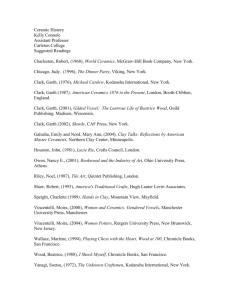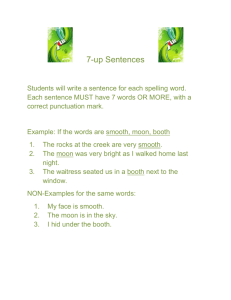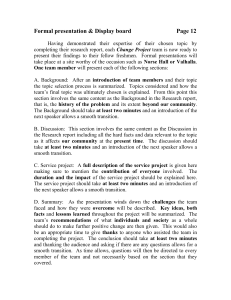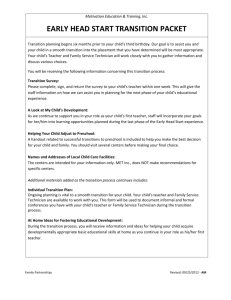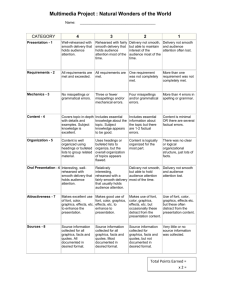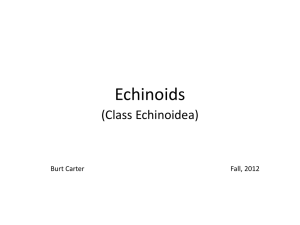J. !7?S - Marine Biodiversity Center
advertisement
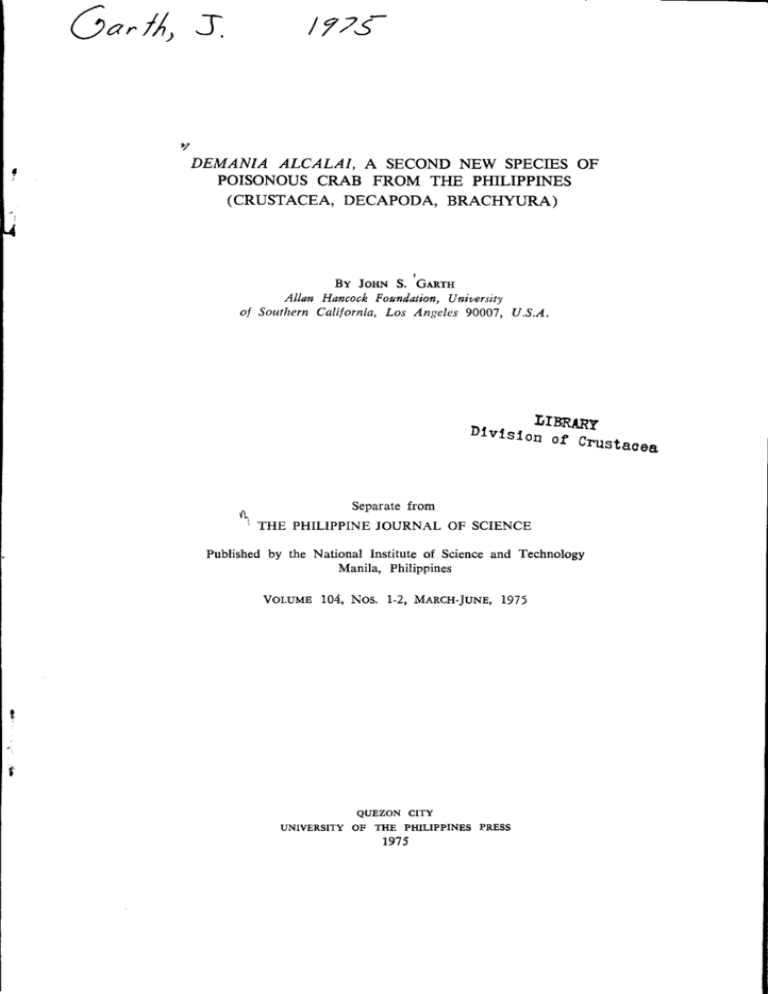
J. V !7?S DEMANIA ALCALAI, A SECOND NEW SPECIES OF POISONOUS CRAB FROM THE PHILIPPINES (CRUSTACEA, DECAPODA, BRACHYURA) BY JOHN S. GARTH Allan Hancock Foundation, University of Southern California, Los Angeles 9 0 0 0 7 , U.S.A. IIHMEr <* c n a t a e . s l o n A 1 Separate from THE PHILIPPINE JOURNAL OF SCIENCE Published by the National Institute of Science and Technology Manila, Philippines VOLUME 104, N o s . 1-2, MARCH-JUNE, 1975 QUEZON CITY UNIVERSITY OF THE PHILIPPINES PRESS 1975 J THE PHILIPPINE JOURNAL OF SCIENCE Vol. 104 March-June, 1975 Nos. 1-2 DEMANIA ALCALAI, A SECOND NEW SPECIES OF POISONOUS CRAB FROM THE PHILIPPINES (CRUSTACEA, DECAPODA, BRACHYURA)* By John S. Garth Allan Hancock Foundation, University of Southern California, Los Angeles 90007, U.S.A. ABSTRACT A second species of the xanthid crab genus Demania is reported from the Philippines with the description and illustration of D. alcalai, new species, from Negros Oriental in shallow water. The new species is compared with other members of the genus from Singapore and Ceylon. As with the earlier described D. toxica Garth, ) this second Philippine species is also known to be poisonous. INTRODUCTION 1 In July, 1971, the writer received from the Research Center of Silliman University, Dumaguete City, Philippines, a large xanthid crab caught by gill net in shallow water off Siaton Town, Negros Oriental. Although several parts of this crab were unfortunately missing, the carapace and chelipeds were intact, and on this basis the specimen was assigned to Demania toxica Garth, ^ the description of which was in progress. A note inserted in proof as an addendum to the description gave measurements of this male, but no other particulars. Two additional specimens collected in October, 1973, reached the writer subsequently: an intact female in December, 1973, and •Allan Hancock Foundation Contribution No. 354. Philipp. J. Sci., 104(1-2), 1975: 1-6. ^ V ^ r U S t a c e a D i v i s i o n of i / r u f * 1975 The Philippine Journal of Science 2 a male in July, 1974, which, although lacking maxillipeds, retained the abdomen and pleopods that were missing from the male received three years earlier. By this time it was apparent that these three specimens represented a second species of Demania from the Philippines, also new to science, and that the earlier assignment of the large male to D. toxica was an error. That this species was also poisonous was demonstrated by the work of Professor A. C. Alcala of Silliman University and his associate, Miss Esther E. Carumbana. Dr. Alcala will report independently on the results of his toxicological studies; it suffices here to note that the same three specimens have served in double capacity: their soft parts for biological assay and their hard parts for taxonomic description. Acknowledgment is made to Professor Alcala for permission to describe the new species and to retain the holotype and paratypes in the Allan Hancock Foundation (A.H.F.), to Miss E. E. Carumbana for supplying relevant data, and to Dr. R. Serene, former UNESCO marine science regional expert for Southeast Asia, whose manuscript key to Demania was used in this study. Illustrations by Mr. Jerry J. Battagliotti were made possible by a subvention from the Research and Publication Fund of the University of Southern California. DEMANIA ALCALAI sp. nov. Figs. 1-6. Demania toxica Garth (1971) 183 (part: the 75 by 94 mm male only). Type. — Holotype female, A.H.F. No. 731, from off Bantayan Barrio, Dumaguete City, Negros Oriental, Philippines; October 10, 1973; caught in bamboo fish trap in 3 feet of water; Jesus Cimafranca, collector. Paratype male, from Piapi, Dumaguete City, Negros Oriental; October 10, 1973; coral reef, 3 feet; Calixto Cimafranca, collector. Paratype male, from off Siaton Town, Negros Oriental; June, 1971; caught in gill net; collector unknown. Specimens received from A. C. Alcala, Silliman University, Dumaguete City, Negros Oriental, Philippines. Measurements. — Female holotype, length of carapace 38.5 mm, width of carapace 74.1 mm, of front 16.6 mm, of fronto-orbit 31.3 mm, length of chela 43.0 mm, of dactyl 22.0 mm, height of palm 21.5 mm. Male paratype, length 57.1 mm, width 72.2 mm. Male paratype, length 75 mm, width 94 mm. Diagnosis. — Front produced, median notch narrow, lobes concave. Carapace and chelipeds largely smooth, a few squamose tubercles laterally and posteriorly. Anterolateral margins dentate, 104, 1-2 Garth: Demania Alcalai 3 FIG. 1. Demania alcalai sp. nov.: Female holotype: 1, dorsal view; 2, right chela; 3, frontal view; 4, left outer maxilliped. Male paratype: 5, abdomen; 6, first pleopod. Scale for figs. 1-5 = 10 mm: for fig. 6 = 0.5 mm edges denticulate. Walking legs smooth, crested above and below. Male first pleopod with a row of 23 to 24 longer setae on convex margin. Description. — Carapace pentagonal, front advanced, anterolateral margins arcuate, toothed, posterolateral margins straight. 1975 The Philippine Journal of Science 4 Surface convex anteroposterior^, slightly so from side to side. Regions defined by shallow grooves, areoles devoid of squamiform tubercles anteriorly and medially, tubercles of posterior portion of carapace confined to outer slope. Front produced medially, divided by a narrow, button-hole slit into two concave lobes, each with an outer lobule. Orbital border smooth, inner margin swollen, outer margin with two superior notches, lower margin with an outer notch and an external and internal tooth. Anterolateral margin arcuate, edge thin, denticulate, divided by grooves into four larger teeth excluding the exorbital tooth, first tooth a cluster of tubercles, second tooth low, tuberculate, third and fourth teeth prominent, triangular, blunt-tipped, fourth tooth flattened, directed horizontally, making a shallow angle with the straight or slightly convex posterolateral margin. External maxilliped smooth, punctate, glabrous, ischium grooved, merus dimpled, strongly produced at anteroexternal angle, anterior margin concave. Subhepatic and pterygostomian regions finely tuberculate above, smooth below. Chelipeds subequal, merus, carpus, and manus mostly smooth but with some low, scabrous tubercles interspersed with fine hairs. Merus crested above, grooved and notched distally; carpus smooth above, tuberculate and grooved externally, tuberculate and hirsute internally, a stout spine at inner angle and a tubercle beneath; manus tuberculate above, with five or six larger tubercles forming a superior crest; outer surface of palm largely smooth and bare, with faint indication of tuberculate ridges continuing on pollex. Dactylus with an entire superior crest and an external carina, meeting pollex with two teeth in narrow gape; pollex slightly deflexed, basally grooved, bearing five prominent teeth of which the second tooth is largest, the last terminal. Walking legs compressed, the merus, carpus, and propodus crested above, the merus doubly and the propodus singly crested below. Surfaces smooth or faintly etched, dactyli straight or slightly curved, edges furred. Male abdomen with segments 1 and 3 slightly wider than segment 2, segments 3 to 5 fused, transverse bars on segments 2 to 4 becoming fused and obsolete on segments 5 and 6, abdomen narrowest opposite base of segment 6, segment 7 with sides angularly concave, tip rounded. Female abdomen smooth and punctate, a suggestion of fused tubercles marginally. Male first pleopod slender, cylindrical, gradually tapering and 5 curving toward tip; convex margin with a row of 23 to 24 long, feathered set® distally and a row of short setae proximally; concave margin with one or more rows of short setae proximally and a single longer seta at base of beaklike tip. The outer maxillipeds and last pair of walking legs are missing from the smaller male paratype, the abdomen and its appendages from the larger; hence the selection of the female specimen as holotype. Remarks. — The proposed new species differs from Demania scaberrima (Walker), ) the most nearly related species for which full description and illustration are available, in having the carapace much less scabrous on the anterior three-fifths, areoles 1M, 2M, 3M, 4M, 1L, 2L, 5L, and 6L (of Dana), lbeing entirely smooth, in having the front more advanced medially, the orbits smooth, the anterolateral teeth more salient, especially the last tooth, which forms an obtuse angle with the straight posterolateral border, the chelipeds much less scabrous, particularly the upper surface of the carpus and external surface of the manus, the superior margin of the dactylus entire and with only one outer carina, the walking legs all alike (the merus of the last not spinulous), their rims entire above and below, their meri lacking a subterminal notch. It is apparently nearer to D. cultripes (Alcock) T (non Sakai), ) which it resembles in having the tubercles on the mesogastrium not only "still more worn" [than D. baccalipes (Alcock),] ) but entirely absent and the carpus of the cheliped with a stout spine at its inner angle (from the Serene key, unpublished). It differs from D. cultripes, however, in having the tubercles hear the inner angle of the wrist and near the base of the thumb entirely absent, leaving the carpus and outer surface of the manus smooth and bare, and in having the raised rows of granules on the dorsal surface of the leg-joints obsolete, rather than obsolescent. It should be noted that the presence or absence of tuberculation depends to some extent on the age and size of the individual, and that the younger of the two males approaches D. cultripes more closely in this particular. The larger male paratype was mistakenly referred to Demania toxica Garth ) in a note added in proof to the description of that species. Garth: Demania Alcalai 104, 1-2 2 3 4) 5 4 1 fThe Demania cultripes mentioned above is the Xantho (Lcmhoxanthus) cultripes of Alcock, ' the Xantho reynaudii cultripes of Sakaif > being recognized as Demania rotundata (Serene), ) (Serene and Lohavanijaya). ' 4 6 7 6 The Philippine Journal of Science 1975 REFERENCES (1) J. S. Garth, Micronesica, 7 (1971), 179. (2) A. O. Walker, J. Linn. Soc. Lond., Zoo}., 20 (1887), 107. (3) J. D. Dana, United States Exploring Expedition During the years 1838, 1839, 1840, 1841, 1842, under the command of Charles Wilkes, U.S.N. Vol. 13, Crustacea: (viii) 1618, Phila., 1852. (4) A. Alcock, J. Asiat. Soc. Bengal, 67 (1898) 67. (5) T. Sakai, Studies on the Crabs of Japan, IV. Brachygnatha, Brachyrhyncha, Tokyo, 1939, p. 365. (6) R. Serene, Cah. Pac., 13 (1969), 223. (7) R. Serene and P. Lohavanijaya, Naga Rep., 4 (4) (1973), I. 4 * > V s

